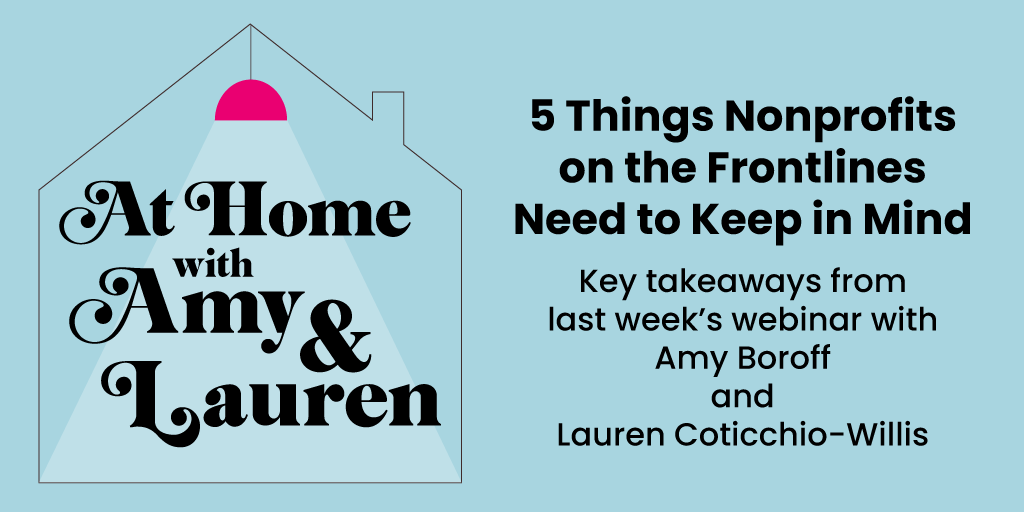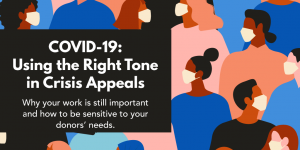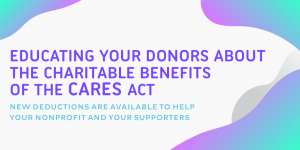Online events, digital-first strategies, and crisis appeals have defined the first five months of the coronavirus pandemic for nonprofits. And while organizations have done a great job adapting, many are wondering they should do next.
This is especially true for nonprofits on the pandemic’s frontlines. Many of these organizations are asking themselves, “what comes next?” as they look ahead to their year-end push.
This month’s webinar, At Home With Amy and Lauren: What’s Next for Nonprofits on the Pandemic’s Frontlines, sought to answer that question.
Lauren Coticchio Willis, the Director of Individual Giving at the Hackensack University Medical Center Foundation, joined Action’s Development Strategist, Amy Boroff, to share her experiences and help nonprofits as they move forward.

Reframe the Story
If you haven’t already, it’s important to start sending appeals again. But the story you usually tell in your appeal may not work this year. Lauren used the HUMCF’s Nurses’ Day Appeal as an example of how the foundation reframed their story for a spring appeal.
“In May, we traditionally recognize Nurses’ Day and fundraise for our nursing scholarship. We recognized early on the message had to change. We can’t do a feature story of a nurse that received the scholarship. We have to just highlight the fact that nurses are on the frontline and they’re incredible right now.
This is how we help them to continue doing their work. We support them in furthering their education, which makes them better nurses, which provides them to be able to give better care. But we also promote nursing as a profession, which is a really important thing to do right now. We still put it out there, we just changed the message.”
The result? This year’s Nurses’ Day appeal outperformed prior year’s versions of the appeal! Keep this example in mind as you develop your year-end appeal.
Flexibility is Key
Flexibility has always been important for nonprofits. But now, it’s critical. You may find that you need to push yourself out of your comfort zone and adjust on the fly, more so than usual this year.
“Flexibility is key right now. It’s hard for any of us who are Type A and are used to driving projects and used to being really strong in following timelines. It definitely causes anxiety for us as human beings. But what I have found solace in is the core of ‘you can’t stop asking for help.’
Yes, for healthcare some of the peak in terms of number of inpatients is behind us for now. But there is still a lot of work to be done. And the work that we do every day for all of our patients is still incredibly vital.”

Planning Ahead
Nonprofits on the pandemic’s frontlines are faced with a unique challenge. They need to keep planning ahead, while putting an emphasis on being flexible. It sounds like a bit of an oxymoron. But as Lauren says, it’s about prioritizing timelines, maintaining contact, and making adjustments on the fly.
“With appeals, it’s the same schedule. If we stop or if we hold back, all of a sudden, we’re off schedule and we’re not raising money. But it’s adjusting the language, being responsive to what’s happening, and knowing that with digital, we can change right up until the second before it goes. So, it’s flexible and it’s easy.
With mail, it’s hard trying to make sure your timelines are as tight as they can be. I love having them because it makes it easy to be flexible, to change, and have time for one thing to run over. But the reality is, sending something to your designer a month ahead of time is not the way that you’re going to be successful right now. It doesn’t work because if you do it, you’re going to re-do it three times before it goes.”
Your Next Appeal
Lauren said that HUMCF is moving forward with their end-of-year appeals, which include specific appeals for Pediatric Cancer Awareness Month and Blood Cancer Awareness Month.
“Those things still need to happen, and those patients still need our help. So, we’re making sure the messaging reflects what’s happening elsewhere. We don’t want to pretend that we’re not aware of what’s going on. We’re being flexible because right now, September is a very long way away. Things change every day. It’s remaining flexible and not overthinking it.

Re-allocation and Collaboration
Healthcare organizations and other nonprofits on the pandemic’s frontline saw a lot of support from their communities at the beginning of the pandemic. As things become more stable, your organization can look for ways to give back to those who supported you.
“The hospital was so proud and shocked by the amount of community support, so much so that the hospital had to set up a team to manage the flood of donations. Anything from supplies to food, to these wonderful treat bags.
That went on until early June, but obviously once our numbers started to go down, we wanted to replace that incredible support. Because while it’s amazing to receive it at the hospital, there are so many people in need.”
So, Hackensack and other area hospitals partnered with the Center for Food Action to re-route food donations to go through the Center. The goal is to get the food to the people who need it most right now. It was a way for the hospitals to give back after they received so much initial support from the community.
Looking for More Advice and Real Examples?
Amy and Lauren talked about so much more than we can cover in a single blog post. If you missed the live webinar last week, you can watch the full recording below!
And don’t forget to click the images below to catch up on what you missed during our previous two webinars!







